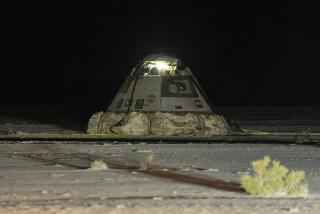Discovery’s Launch Delayed Again
- Share via
KENNEDY SPACE CENTER, Fla. — NASA officials on Monday again postponed the launch of the space shuttle Discovery, saying that days of electronics testing have not unraveled the cause of a sensor failure that forced a launch delay last week.
The earliest possible launch date now is a week from today, officials said.
If the launch is delayed much more, officials said, it could jeopardize Discovery’s chances of taking off before the end of the current window, which closes July 31.
Teams are now studying the possibility of extending the launch window into early August. The next opportunity to launch Discovery is in September.
“We’re still looking for the problem,” said Bill Parsons, shuttle program manager. “We’re trying awfully hard.”
The first shuttle launch since the loss of Columbia in 2003 was called off Wednesday, 2 1/2 hours before liftoff, after an engine cutoff sensor in the shuttle’s giant external tank failed to respond to commands.
Since then, engineers across the country -- including the original designer of a critical piece of circuitry who came out of retirement to offer his help -- have been working on the problem.
“Ben Franklin said energy and persistence will conquer all things,” said N. Wayne Hale Jr., deputy shuttle program manager. “We will conquer this problem.”
But after testing two-thirds of the wiring and circuitry connecting the sensor to the shuttle’s computer, engineers are still perplexed.
On Friday, a component called the point sensor box had emerged as the prime suspect. But over the weekend, the box and its electronics cards passed all tests.
Ed Mango, orbiter deputy manager, said workers also tested the wiring in Discovery, along with the umbilical cable connecting it to the external fuel tank. Those systems also checked out clean.
A few possibilities remain. One is that there could be a faulty electrical ground somewhere. The other is that something in the cryogenic fueling process is responsible. The tank holds liquid hydrogen fuel at minus 420 degrees Fahrenheit.
Two sensors in the same area had failed during a tank fueling test in April. But workers never found the cause. Instead, they simply swapped the fuel tank and inserted new cables.
More to Read
Sign up for Essential California
The most important California stories and recommendations in your inbox every morning.
You may occasionally receive promotional content from the Los Angeles Times.













